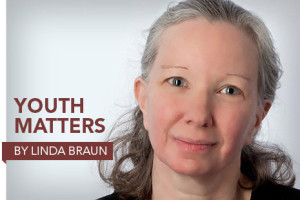
You need to get out of the library to build relationships and find out what teen interests are.” Workshop participants frequently hear me say that, and the response to my statement is almost always agreement. Yet I find, over and over, that public library staffers prioritize getting teens into the building over getting themselves out.
I’ve thought a lot about this disconnect and realized that, at least in part, library staffers continue to stay inside because of systemic barriers. What are some of these barriers?
Job descriptions. Think about how your work is defined. Do your responsibilities include regularly going outside of the building to build relationships with teens and community partners? If not, your organization’s expectations of what you need to do to be successful in your role are lacking. How can administrators and colleagues support outreach if leaving the library isn’t a recognized core component of your duties? Looking to the Young Adult Library Services Association’s (YALSA) sample job description can help expand the scope of the teen services librarian.
Schedules. Examine the amount of time—and times of day—you are required to spend at a service desk, such as reference or circulation. Does staffing the library end up marginalizing relationships with teens and community partners? Maybe you do have time “off desk,” but is that time usually when teens are in school?
While reaching teens in school can be valuable, it doesn’t really let you spend time with them when they are engaged in interest-based activities. For example, if you can leave the library during after-school hours, you might go to a Boys and Girls Club meeting and help with a STEM activity. This effort can be a good opportunity to have conversations with teens, learn who they are, and foster connections.
Examine the amount of time—and times of day—you are required to spend at a service desk, such as reference or circulation. Does staffing the library end up marginalizing relationships with teens and community partners?
Mission, vision, and strategic plan. If you dig into these documents, it’s likely you’ll notice that the emphasis is on linking teens with learning opportunities and library resources. Often, the assumption is that this happens within the library’s four walls, and there is little—if any—mention of achieving this work out in the community. As a result, expectations are too narrowly focused.
A first step in overcoming these barriers is to determine what impact you and your stakeholders want teen services to have. You might write or rewrite a statement specifying goals and objectives to clarify your mandate. Consulting resources such as YALSA’s staff competencies and core values can simplify this task. An overall mission might be: “To support all teens in our community in developing the skills they need to succeed in life.”
If that’s the vision, think about how you will achieve it. If you are going to support all teens in the community, then you need to know the needs and interests of a wide variety of adolescents—not just those who already come into the library or are aware of its resources. Talk directly with teens and community members to find out where teens spend time outside of school hours. Then work with adults who staff and administer these spaces to implement activities and events at which you can build rapport.
After you assess your job descriptions, schedules, and organizational documents, write up a set of talking points that highlight why it’s important to leave the library in order to fulfill your mission. Use those ideas with administrators and colleagues to bring about change. If you see that the only way to make a difference in more teen lives is by changing how your work is framed, isn’t it time to get started?


